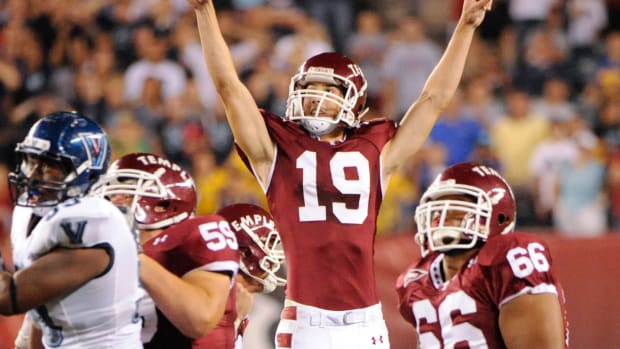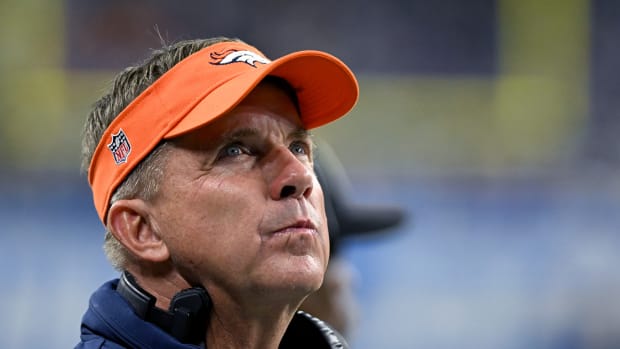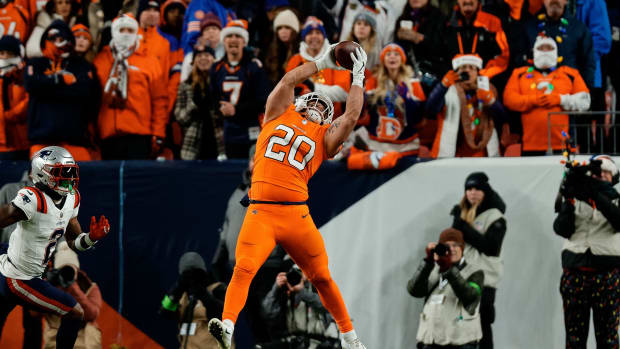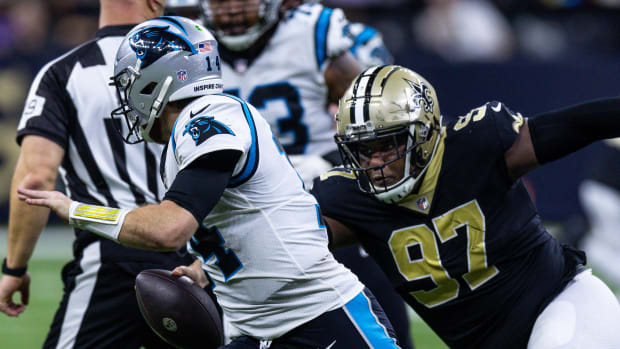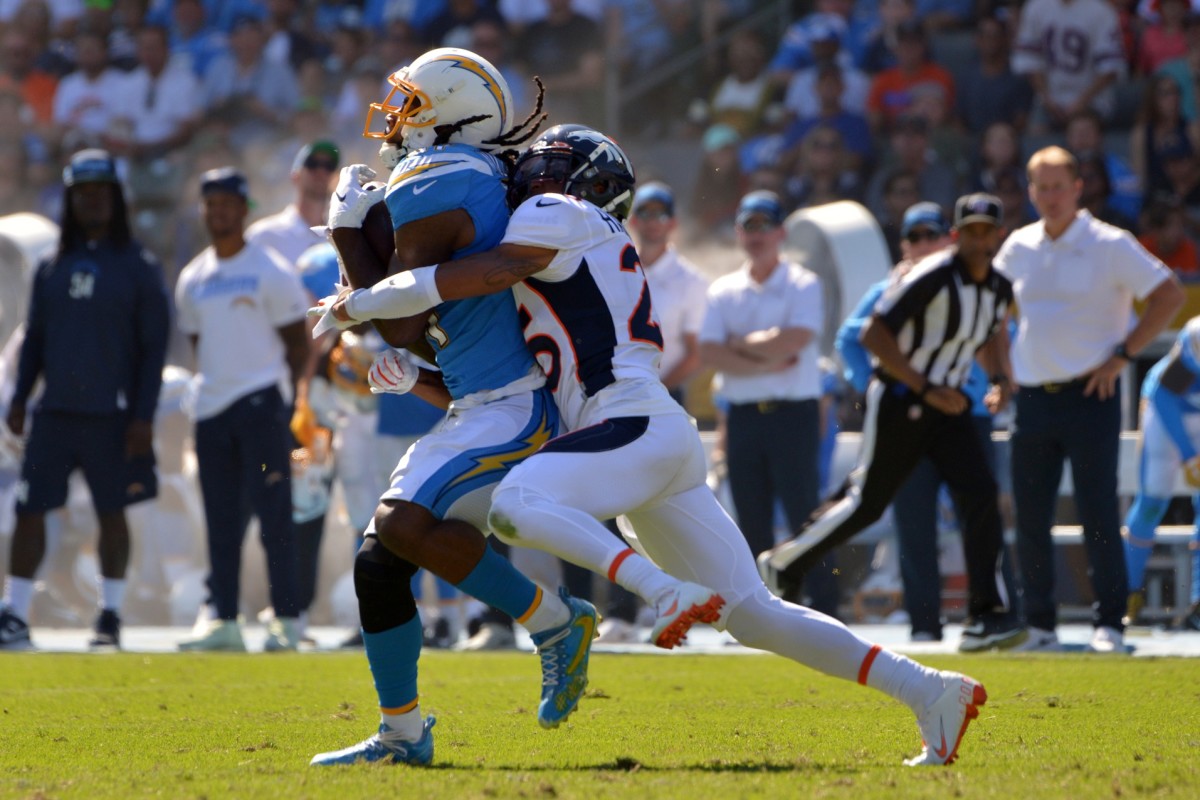
Here's Why Broncos' Top-10 Ranking Against The Pass Is Misleading
The Denver Broncos have given up a total of 1,011 yards passing through the first five weeks of the season. That puts them sixth overall among NFL teams.
That should tell you that the pass defense is in pretty good shape, right?
Well, actually... no.
Head coach Vic Fangio brought up a good point when he spoke to the media Monday. He was asked a question about the Broncos' pass defense and how high it's currently ranked.
Fangio's response was to point out that passing yards given up doesn't account for other factors related to pass defense. He cited penalties in particular — passing yards, for example, doesn't take into account defensive pass interference, which is a spot foul that can lead to big gains for an offense.
Measuring the quality of a pass defense isn't simply done by looking at yardage. You need to look at a lot of factors. Fangio mentioned penalties, but completion rate allowed, yards after catch, passes defensed, interceptions and how often your defensive backs prevent first downs are all factors to consider.
It does help to have a good pass rush, because that can disrupt a quarterback's rhythm and force him to throw the ball sooner than he wants. However, what the coverage units do also matters, because there will be times that quarterbacks will escape the pass rush or otherwise buy time in the pocket.
So let's look at another source to measure pass defense: Football Outsiders.
Completion Percentage
Football Outsiders DVOA accounts for the result of every play to determine where a unit really ranks. It's not a perfect system, by any means, but it tries to paint the big picture regarding a unit, rather than looking at a number.
To that end, the Broncos pass defense ranked 28th overall in DVOA after four weeks. Its ranking was lower than the run defense, ranked 26th overall. (As you would likely guess, the Broncos D is ranked low in overall DVOA at 27th.)
This goes back to what the passing defense has done in all aspects, taking into account the pass rush and the coverage unit. Let's look at some numbers that paint the bigger picture when it comes to coverage.
Per Pro Football Reference, the Broncos are allowing a completion rate of 65 percent. Compare that to other defenses who haven't allowed a lot of passing yards and who have played the same number of games: the New England Patriots (54.2 percent), the Buffalo Bills (57.4 percent) and the Carolina Panthers (62.7 percent), all who are giving up fewer completions.
In other words, despite not giving up a lot of yards, the Broncos are giving up a lot of completions. Now, that may mean the Broncos are good at limiting yards after the catch, but if you really want a good passing defense, you want to limit catches to begin with.
Many Penalties In The Back Seven
On top of that, the Broncos have committed several penalties that have allowed teams to move the chains. Sure, you can point to roughing the passer and defensive pass interference calls that were bad, but not every penalty is a bad call.
Case in point: Isaac Yiadom got called twice for defensive holding against the Chargers, then Davontae Harris was called for defensive pass interference when he replaced Yiadom. In the Chicago Bears game, there were three defensive holding penalties — two on Derek Wolfe, which was certainly silly, but still allowed the Bears free first downs. And against the Jaguars, De'Vante Bausby was flagged for pass interference.
While penalties haven't been huge for the Broncos defense, there have been enough of them to keep drives extended.
You can also look at how many times the Broncos have actually broken up passes — and in a couple of games, they've hardly done that. Against the Green Bay Packers, they did it just twice — both times by De'Vante Bausby. Against the Jacksonville Jaguars, Denver did it only three times, with Justin Simmons doing it twice and Bausby doing it once.
So how did the Broncos go from the days of the No Fly Zone to a pass defense that isn't getting the job done as well as it should? It's easy to point to more recent issues, such as the signing of Bryce Callahan (who aggravated his foot injury) or the play of Isaac Yiadom this season.
However, a deeper look shows a few things that needed to fall into place to ensure the Broncos could do a good job of pass defense.
• Off-ball linebacker play: When the Broncos had to make a choice between extending Danny Trevathan or keeping Brandon Marshall, the Broncos opted to go with Marshall. Trevathan hasn't been a standout by any means, but he's proven to be more effective than Marshall the past couple of seasons.
Many Broncos fans like to give Todd Davis grief, but while he certainly isn't elite, he plays better than he gets credit, especially in run defense. However, that makes him better as a two-down run stopper, rather than an every-down player.
And the Broncos have been lacking in terms of off-ball linebackers who can come in on passing downs. Corey Nelson was solid in the past, but he opted to seek his fortunes elsewhere, before he came back to the Broncos this season. Joseph Jones showed potential last season, but he's missed time with injuries and isn't proven as a long-term solution.
More importantly, the Broncos never addressed the depth behind Marshall and Davis in past seasons. Not until 2018 did the Broncos draft LB help, selecting Josey Jewell and Keishawn Bierria — and Bierria is no longer on the team.
I know some Broncos fans will scream about Devin Bush, but he wouldn't have been the solution by himself (and he hasn't been perfect this season, even if highlight films suggest otherwise). This area is more than about one player — it's been a long-term issue of not developing quality players at the position.
• Roby failing to develop into a starter: When the Broncos spent a first-round pick on Bradley Roby back in 2014, the expectation was that he could become a long-term starter at some point. Roby was good as the No. 3 cornerback and, when called upon to start, he had several quality games.
That is, until he was officially made a starter last season, had a bad start and, after getting back on track, failed to finish strong, particularly when he had to become the top cornerback after Chris Harris, Jr. was lost to injury. If Roby had developed into a worthy starter, we aren't having conversations about Bryce Callahan because Roby would have been extended.
• Inconsistent cornerback drafting and development: Go back to 2015 and ask yourself about the cornerbacks selected who proved to be long-term answers as either a starter or a depth player.
It's not a good track record. Taurean Nixon, a 2015 seventh-round pick, was always going to have an uphill battle. However, 2015 fifth-round pick Lorenzo Doss showed promise, but was waived during the 2017 season.
The Broncos spent a 2017 third-round pick on Brendan Langley, a selection you want to use on contributors by their third season, but Langley never was anything more than a solid special teams player and was eventually converted to wide receiver before the Broncos moved on.
2018 third-rounder Isaac Yiadom still hasn't figured things out, but there's hope he might, so long as the current staff coaches him up well. Yiadom's issues seem to be more about his mental game and dwelling on mistakes.
I don't think he necessarily got the best coaching as a rookie, so hopefully the new coaching staff can correct his bad habits and get him focused on moving past mistakes.
• Simmons not reaching the level of his sophomore campaign: It seems a long time ago that Justin Simmons was proving himself worthy of a big contract. However, he wasn't as effective in 2018 and, while he's shown good play at times this season, he's had issues with coverage and providing safety help.
Perhaps the coaches were wrong to view Simmons as a free safety — he did play mostly strong safety in 2017. On the other hand, he played that position a fair amount in 2018, too.
Simmons still has time to turn it around. But he'll need to show improvement from this point forward, if he wants to convince the Broncos he can be the long-term guy at free safety.
• Injuries: There is, of course, the factor that every team faces and, in this case, has either hurt the Broncos' depth or has cost them a player who showed promise.
Jamal Carter was injured in 2018 after showing promise as a rookie the year before. Along came Dymonte Thomas in 2018, but he's on injured reserve now.
Of course, there's Bryce Callahan this season and, this past Sunday, the Broncos lost De'Vante Bausby to a cervical spine sprain. And we all remember when Chris Harris, Jr. was lost to injury to end last season.
Injuries always suck, but perhaps more so when it's a developing young player who shows promise. It makes you wonder what Thomas could have shown this season, and how much better Bausby could have become, if they hadn't gotten injured.
The Answer(s)
So what are the steps to solving the issues? A lot of it does go back to player development — along with Yiadom, the Broncos need to keep an eye on the development of Davontae Harris, Duke Dawson and Trey Marshall, who all need to demonstrate they can at least be good depth players — and, hopefully, at least one can prove he is a worthy starter in future seasons.
But the Broncos also have to keep in mind that they could lose a starting cornerback, a starting safety and a backup safety to free agency in 2020. Chris Harris, Jr., Justin Simmons and Will Parks all have expiring contracts and it's likely at least two will move on.
The other part is examining off-ball linebacker. Josey Jewell has been inconsistent and it's fair to ask if he's the right fit for Vic Fangio's scheme. Todd Davis may be solid, but 2020 will be the final year of his contract.
Alexander Johnson showed a lot of promise against the L.A. Chargers, but it's just one game. Justin Hollins could miss some time with a sprained knee. And it remains to be seen how much Joseph Jones will contribute now that he's healthy.
The good news is that the 2020 NFL free agency landscape will be deep when it comes to cornerbacks, solid overall at safety, and some intriguing options at inside linebacker. Of course, much depends on which players sign extensions with their current teams or which ones get a franchise tag.
But this goes back to what I've discussed in my ongoing revisions of approaching 2020 free agency; the Broncos need to take a close look at off-ball linebackers and cornerbacks. The draft might not be the best place to get an off-ball linebacker, so unless a current player proves he can be an every-down guy, the Broncos will need to find one in free agency. And while the cornerback draft class holds promise, getting a veteran will be important should Harris move on.
If the Broncos lose both Simmons and Parks in free agency, they at least need to sign one young free agent who can start for the short term, then be prepared to draft somebody.
Most of all, the Broncos need to do a better job developing these players and not reach for somebody with raw talent but plenty of athleticism (as they did with Brendan Langley).
Of course, we'll find out more about what the players on the current roster can do in the remaining games. Any younger players who show that they can be major contributors in the future will give the Broncos some peace of mind as they move forward.
Just keep in mind that whether or not those players have a future isn't simply based on how many yards they give up. It's a matter of not giving up completions, avoiding penalties and being disciplined in coverage. That's what really made the No Fly Zone so good, and that's what really defines when a team has a good pass defense.
Follow Bob on Twitter @BobMorrisSports and @MileHighHuddle.

